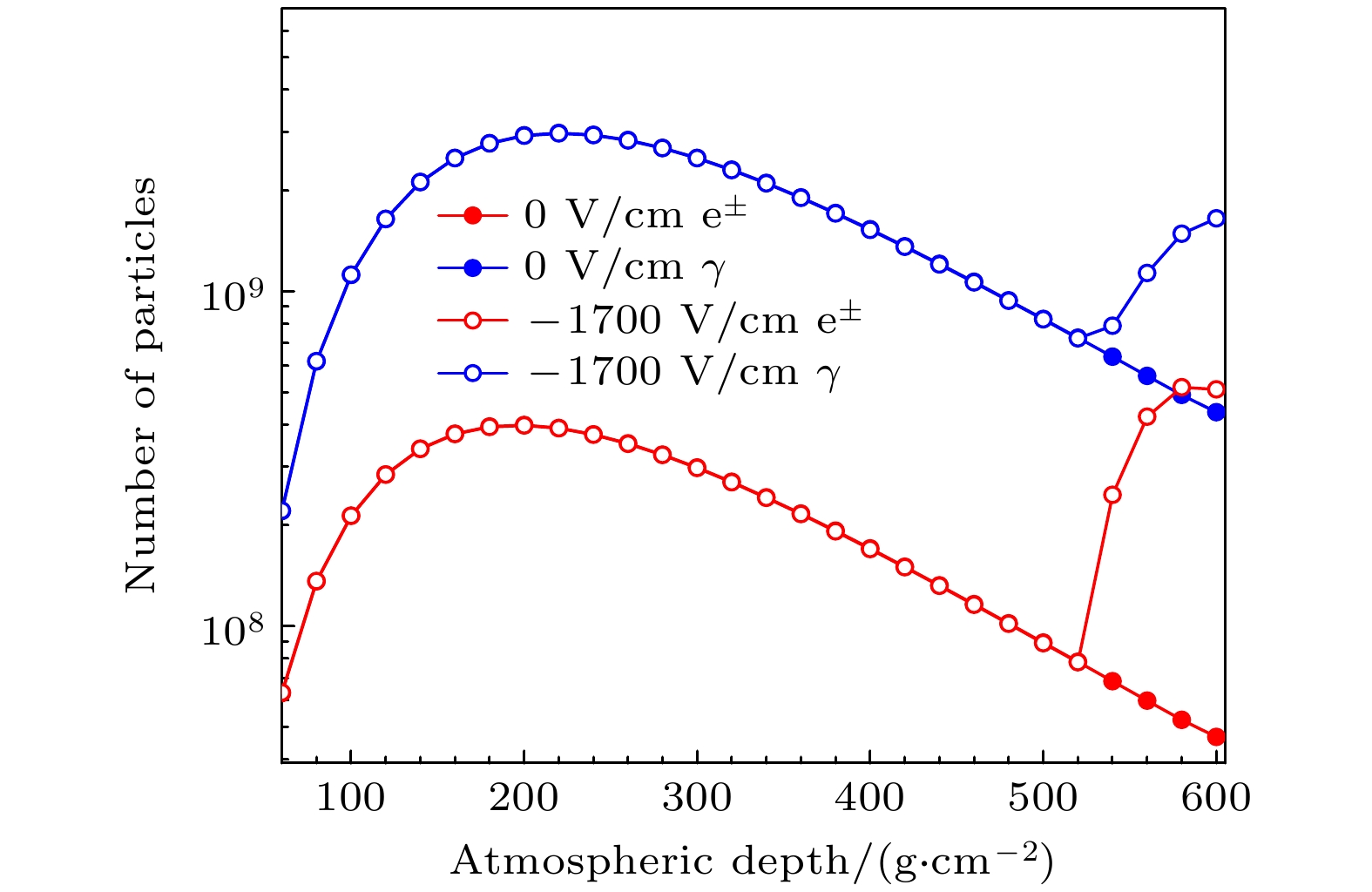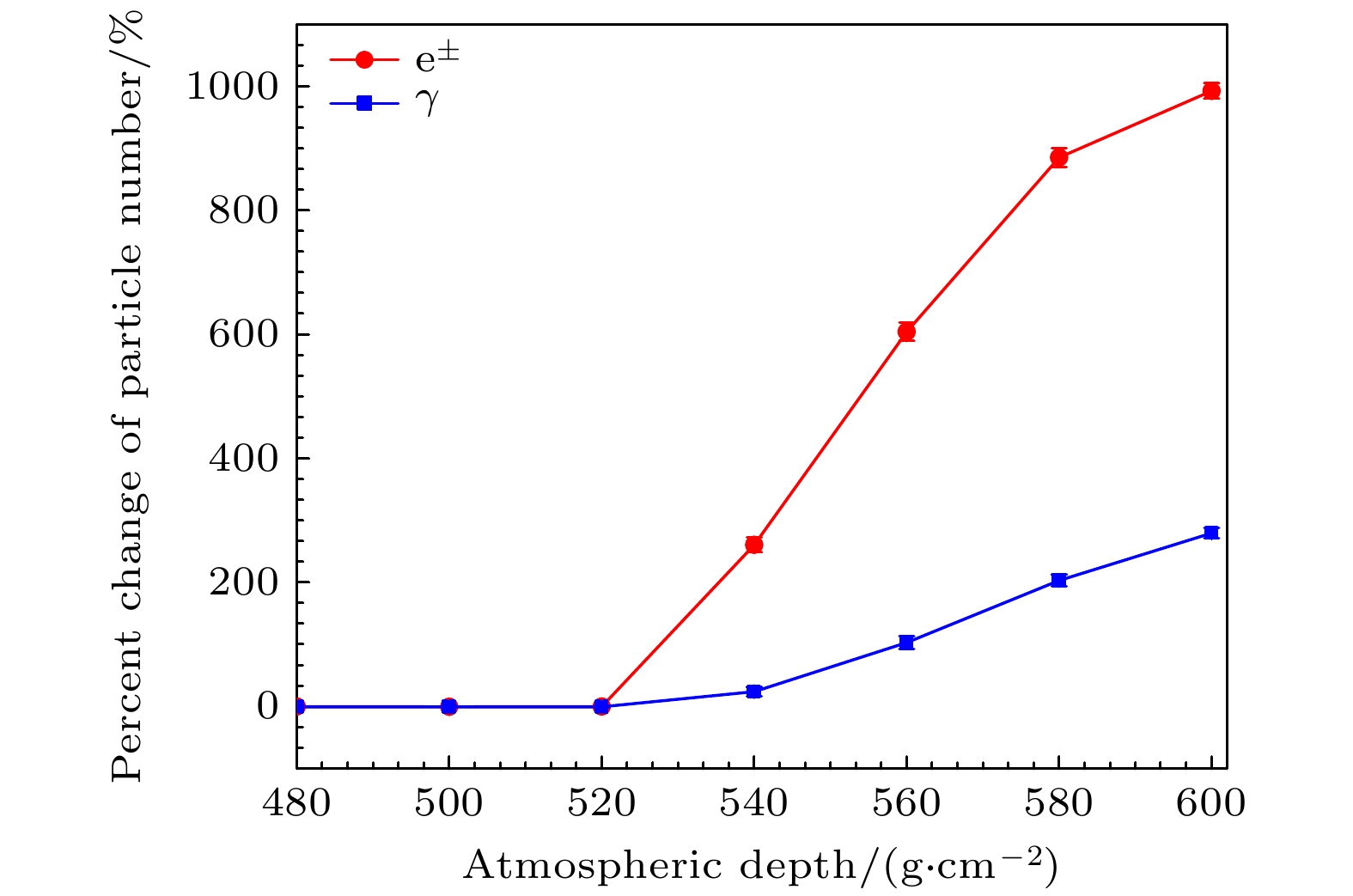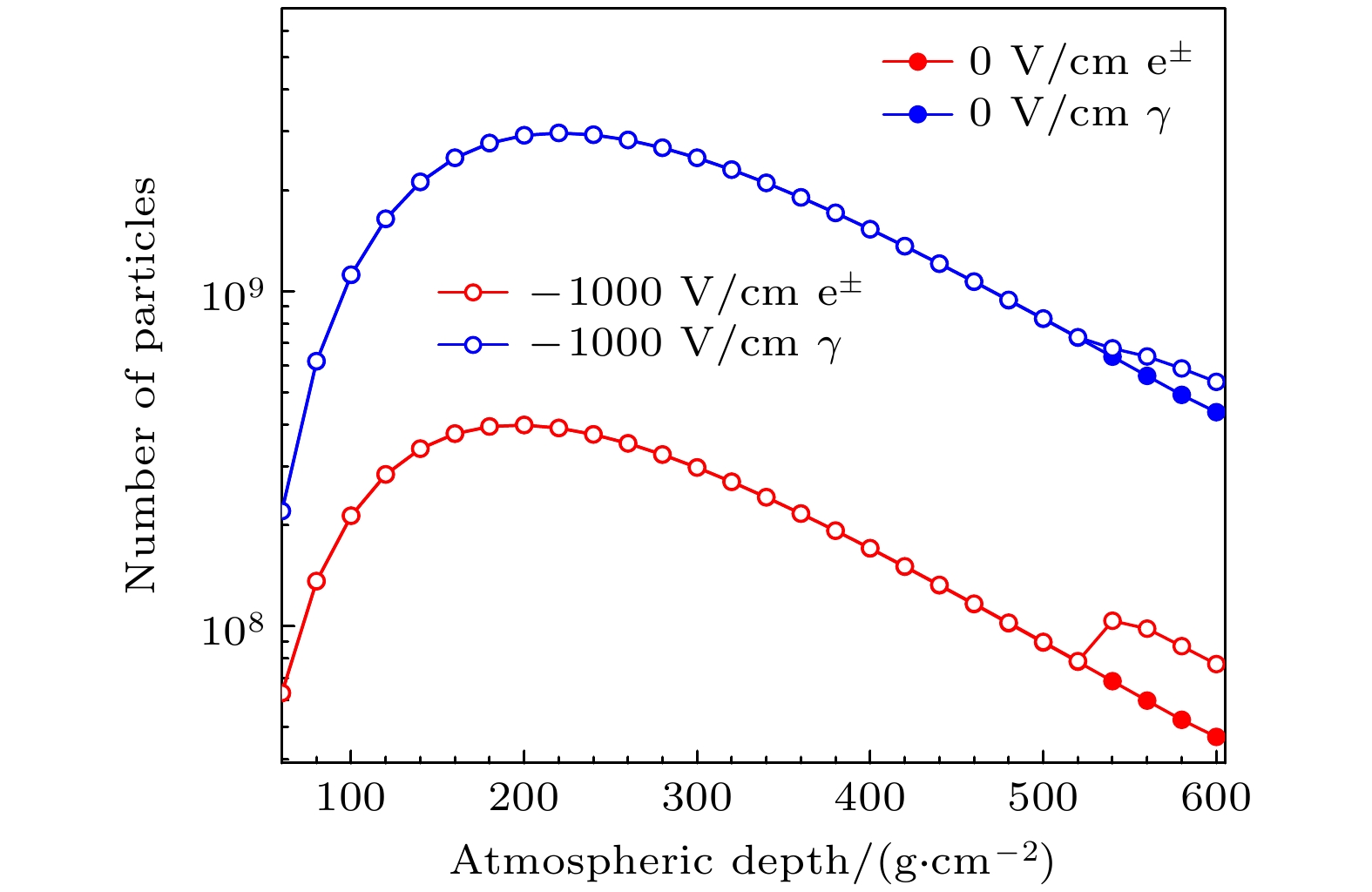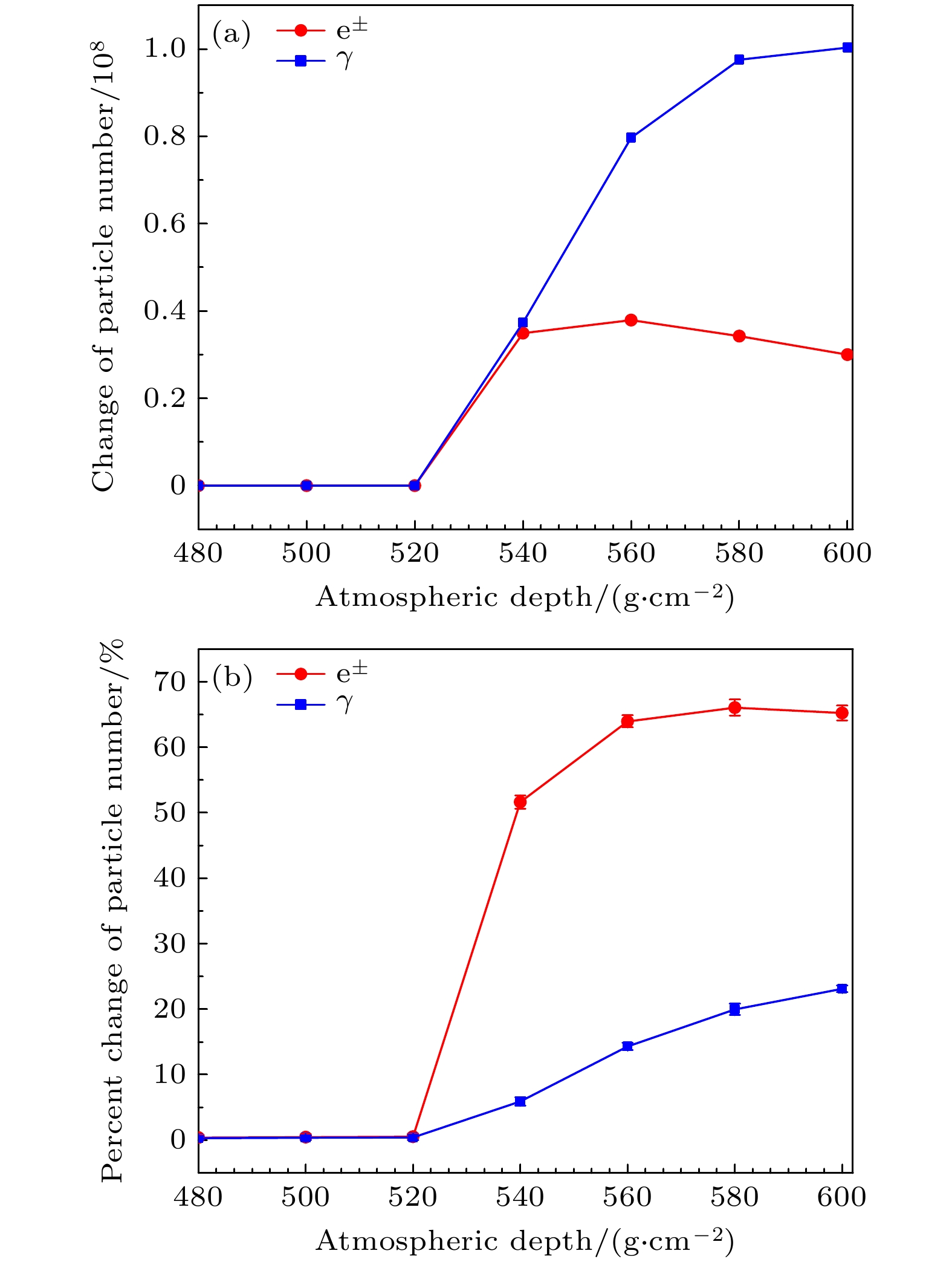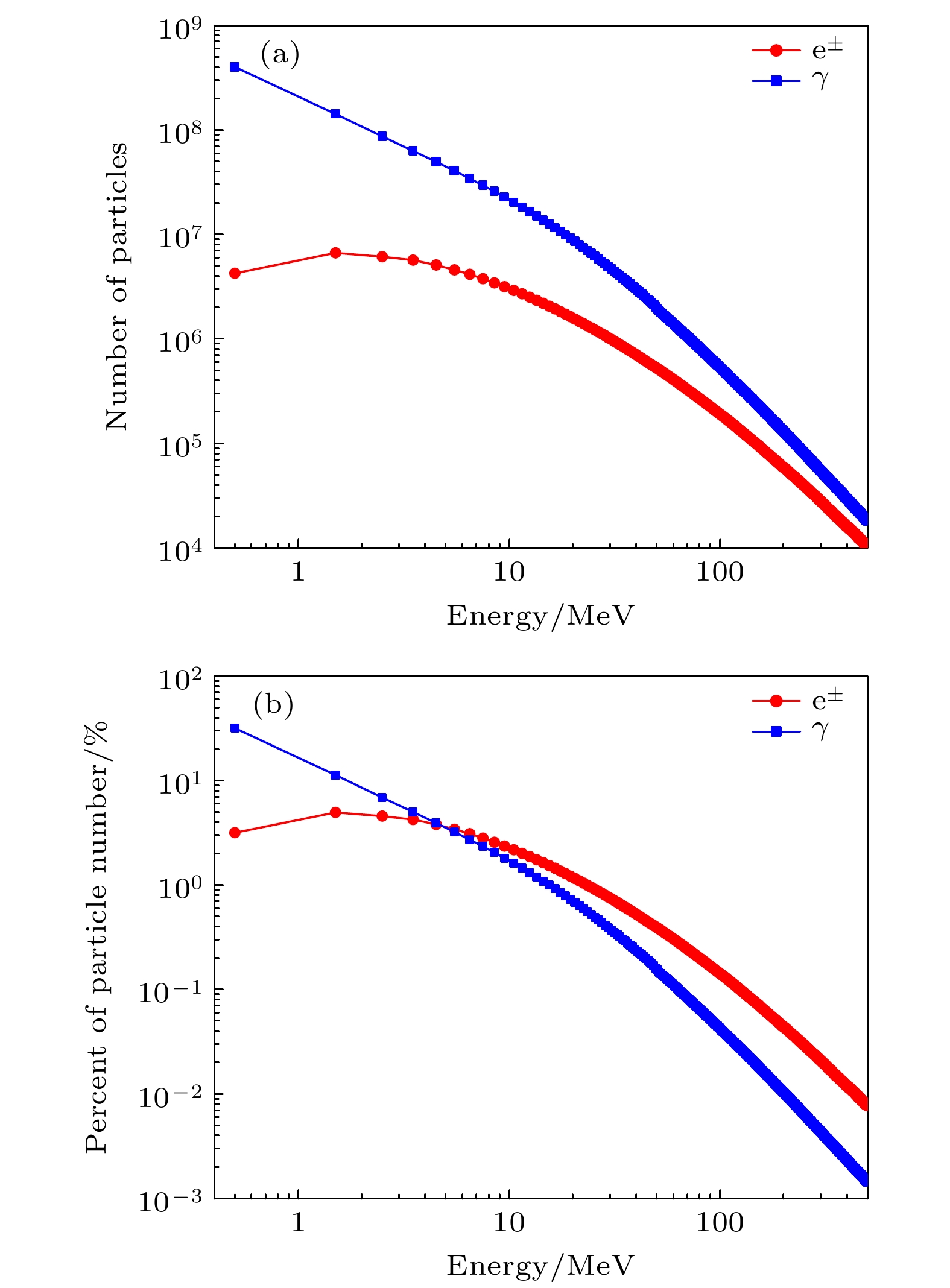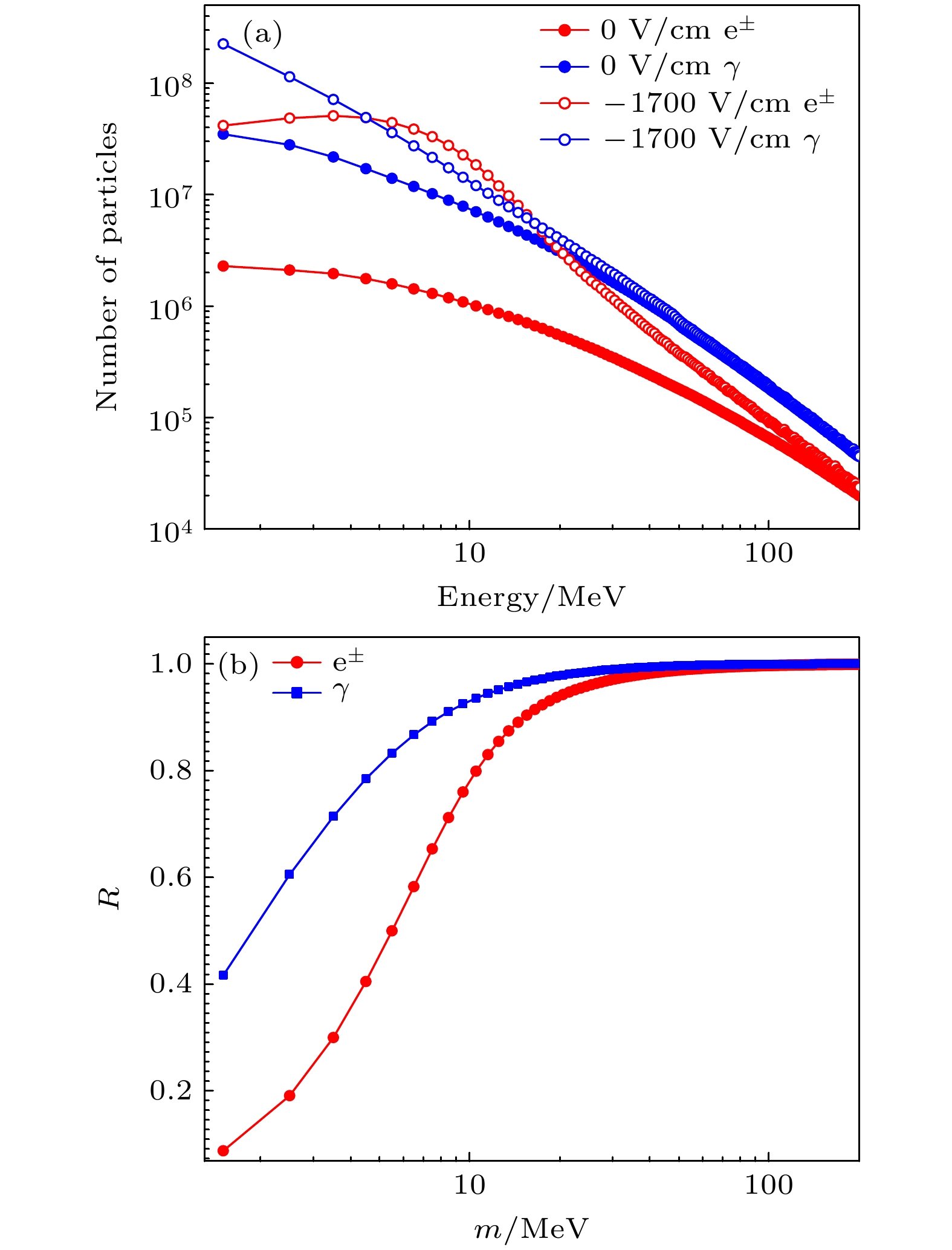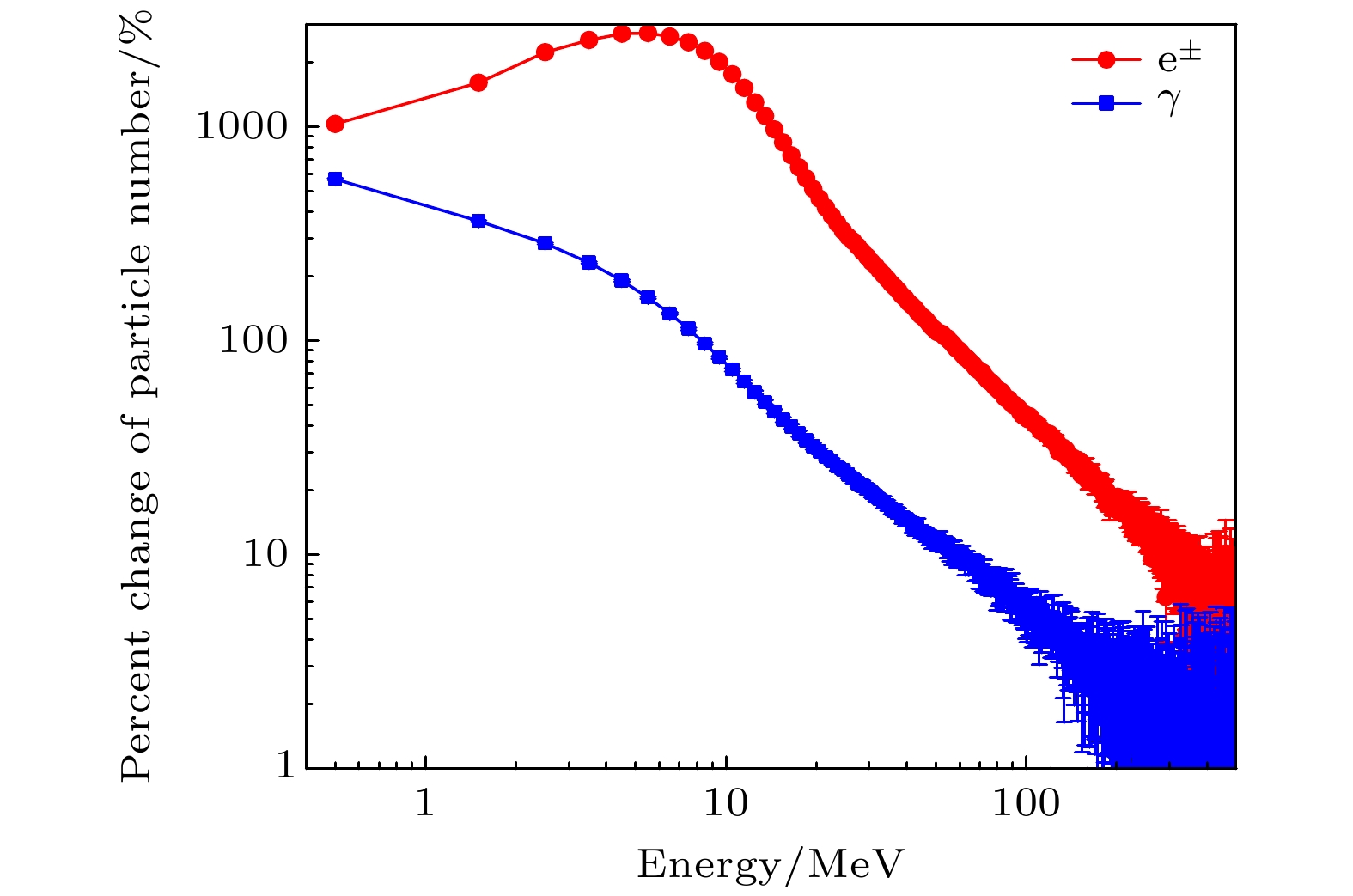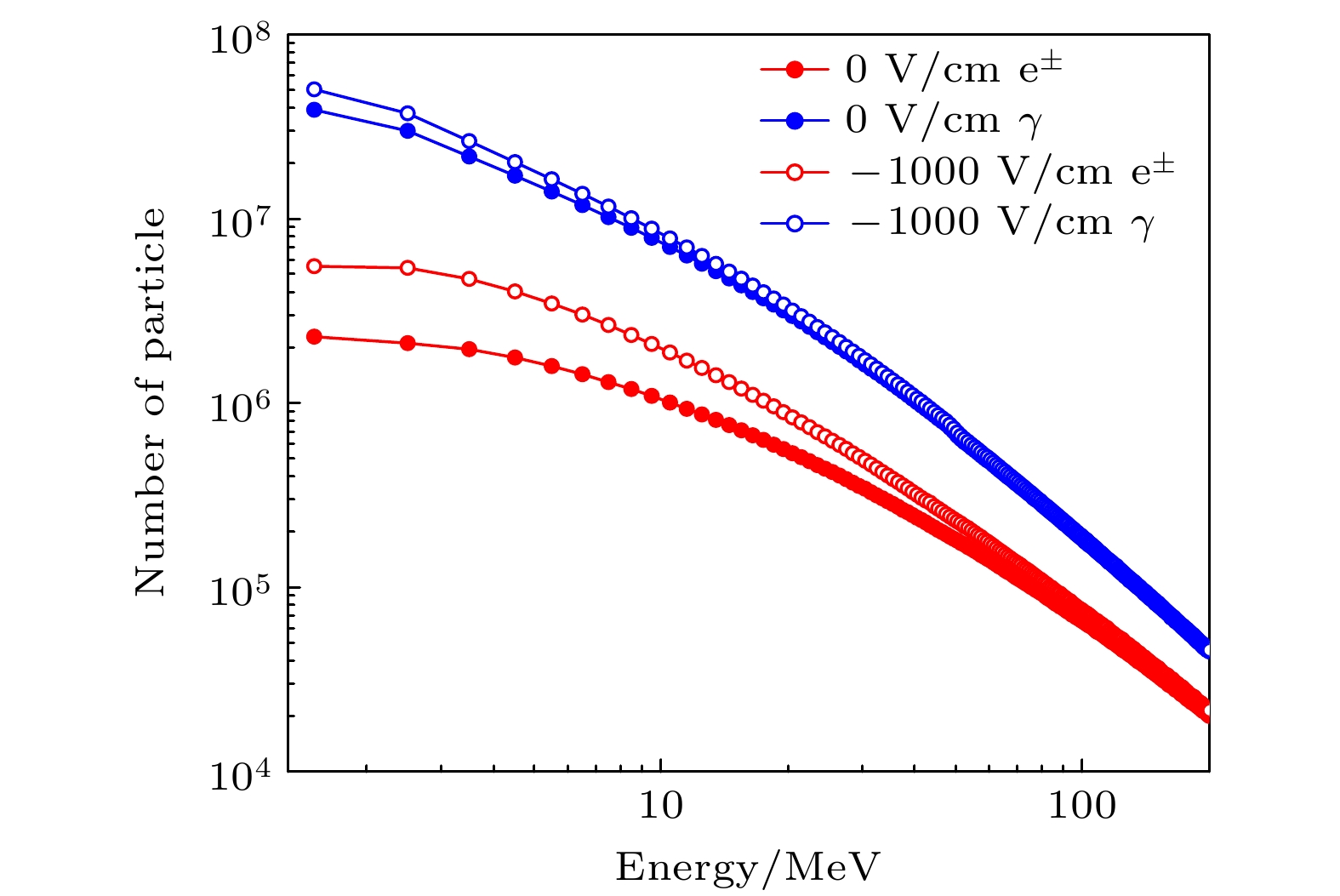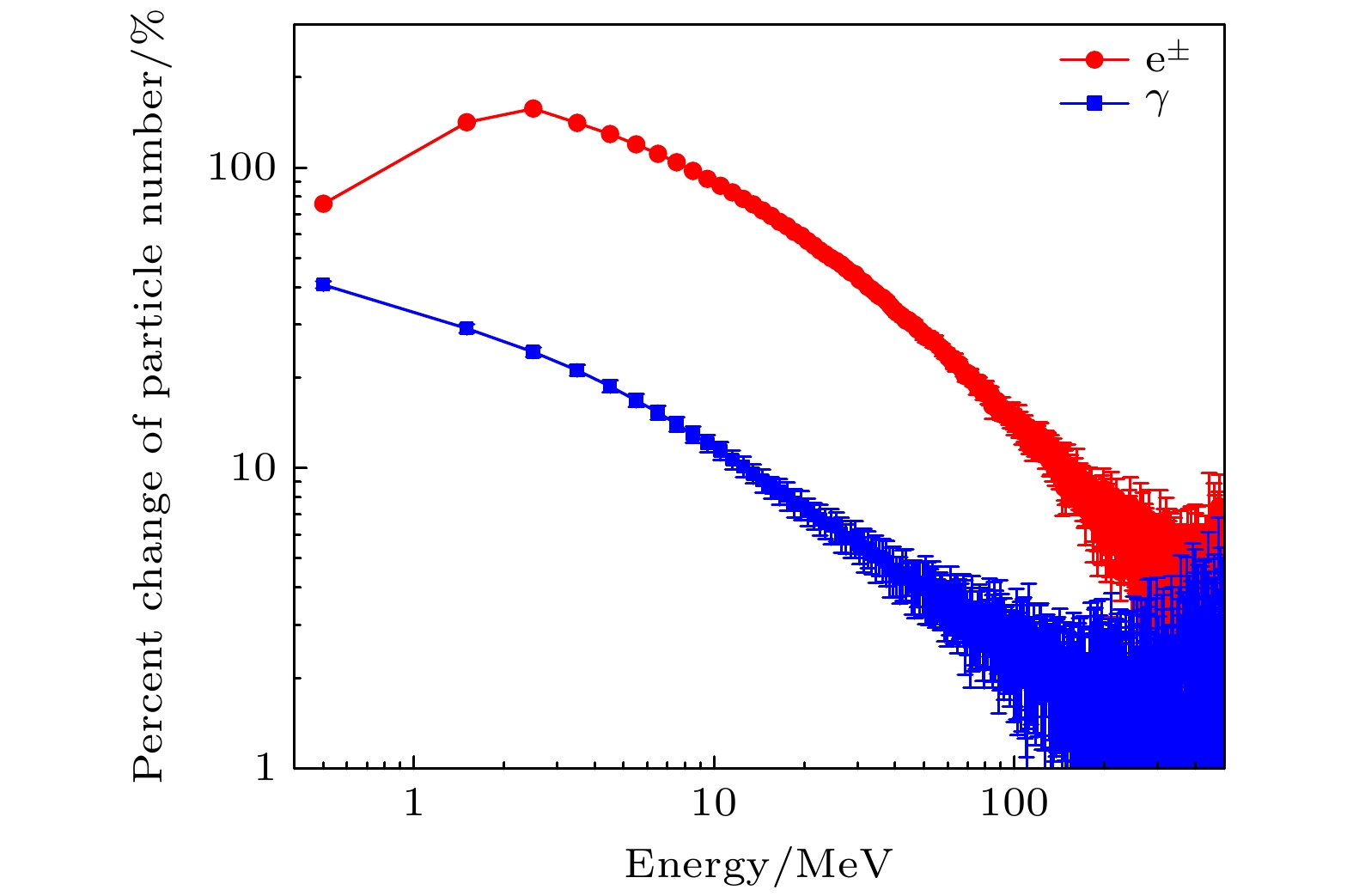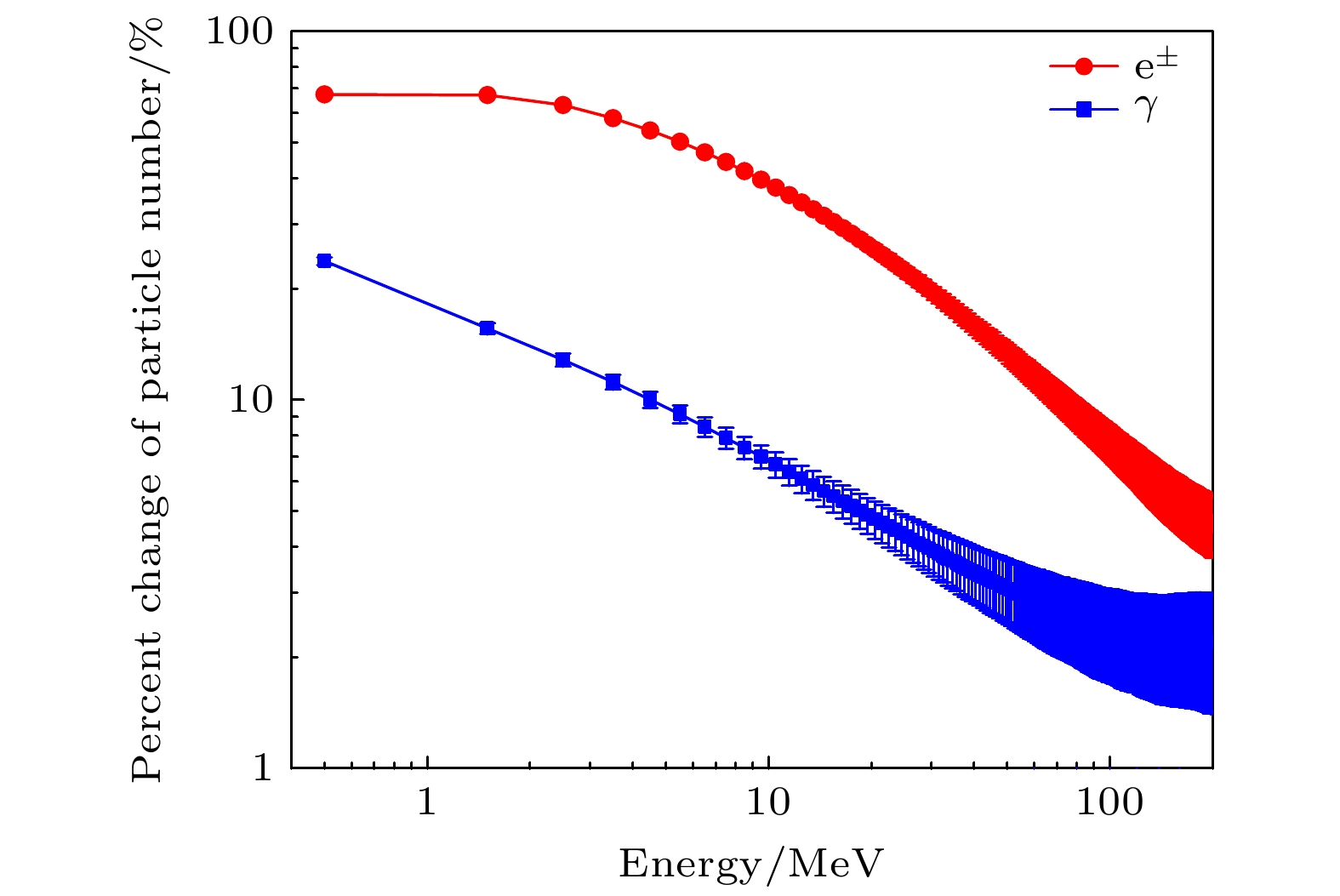-
Large high altitude air shower observatory (LHAASO) is a complex of extensive air shower (EAS) detector arrays, located on the Mt. Haizi (29°21' N, 100°08' E) at an altitude of 4410 m a. s. l., Daocheng, Sichuan Province, China. The information about primary cosmic rays can be obtained by using data from secondary particles measured at LHAASO, with photons make up the majority among these secondary particles. During thunderstorms, the atmospheric electric field can affect secondary charged particles (mainly positrons and electrons), thus changing the information of photons on the ground. In this work, Monte Carlo simulations are performed to investigate the effects of near-ground thunderstorm electric fields on cosmic ray secondary photons at LHAASO. A simple model with a vertical and uniform atmospheric electric field in a layer of atmosphere is used in our simulations. During thunderstorms, the number and energy of photons are found to significantly change and strongly depend on the electric field strength. In a field of –1000 V/cm (below the threshold of the relativistic runaway electron avalanche (RREA) process), the number of photons is increased by 23%. Also, the spectrum of photons softens, and the increased number of photons with energy less than 2 MeV exceeds 29%. In an electric field of –1700 V/cm (above the threshold of the RREA process), the number of photons experiences exponential growth, with an increase of 279%. The spectrum of photons becomes softer than that at –1000 V/cm, and the increased number with energy less than 2 MeV is more than 361%. It is consistent with the theory of RREA. For these phenomena of photons at LHAASO, the main factor is that the number of positrons and electrons are increased due to the acceleration of negative electric field on electrons, with increase of 65% in –1000 V/cm and 992% in –1700 V/cm, and the spectrum of positrons and electrons soften. Newborn free positrons/electrons may undergo bremsstrahlung and deposit part of their energy into photons, causing the change of number and energy of photons to follow roughly the same pattern as positrons and electrons. The simulation results can provide the information for understanding the variations of the data detected by LHAASO during thunderstorms and the acceleration mechanisms of secondary charged particles caused by an atmospheric electric field.
-
Keywords:
- thunderstorms electric field /
- cosmic ray secondary particles /
- Monte Carlo simulations /
- LHAASO experiment
[1] Qie X S, Yuan S F, Chen Z X, et al. 2021 Sci. China Earth Sci. 64 10
 Google Scholar
Google Scholar
[2] 刘冬霞, 郄秀书, 王志超, 吴学珂, 潘伦湘 2013 物理学报 62 219201
 Google Scholar
Google Scholar
Liu D X, Qie X S, Wang Z C, Wu X K, Pan L X 2013 Acta Phys. Sin. 62 219201
 Google Scholar
Google Scholar
[3] 周勋秀, 王新建, 黄代绘, 贾焕玉, 吴超勇 2015 物理学报 64 149202
 Google Scholar
Google Scholar
Zhou X X, Wang X J, Huang D H, Jia H Y, Wu C Y 2015 Acta Phys. Sin. 64 149202
 Google Scholar
Google Scholar
[4] Tsuchiya H, Enoto T, Torii T, et al. 2009 Phys. Rev. Lett. 102 255003
 Google Scholar
Google Scholar
[5] Hariharan B, Chandra A, Dugad S R, et al. 2019 Phys. Rev. Lett. 122 105101
 Google Scholar
Google Scholar
[6] Wilson C T R 1924 Proc. Phys. Soc. London 37 32D
 Google Scholar
Google Scholar
[7] Gurevich A V, Milikh G M 1992 Phys. Lett. A 165 463
 Google Scholar
Google Scholar
[8] Dwyer J R 2003 Res. Lett. 30 2055
 Google Scholar
Google Scholar
[9] Symbalisty E M D, Roussel-Dupre R A, Yukhimuk V A 1998 IEEE Trans. Plasma Sci. 26 1575
 Google Scholar
Google Scholar
[10] Alexeenko V V, Chernyaev A B, Chudakov A E, et a1. 1985 Proceeding of 19th International Cosmic Ray Conference. (La Jolla. USA: International Union of Pure and Applied Physics) pp352−355
[11] Alexeenko V V, Khaerdinov N S, Lidvansky A S, Petkov V B 2002 Phys. Lett. A 301 299
 Google Scholar
Google Scholar
[12] Bartoli B, Bernardini P, Bi X J, et al. 2018 Phys. Rev. D 97 042001
 Google Scholar
Google Scholar
[13] Xu B, Bie Y G, Zhou D 2012 Chin. J. Space Sci. 32 501 (in Chinses) [徐斌, 别业广, 邹丹 2012 空间科学学报 32 501]
 Google Scholar
Google Scholar
Xu B, Bie Y G, Zhou D 2012 Chin. J. Space Sci. 32 501 (in Chinses)
 Google Scholar
Google Scholar
[14] Chilingarian A, Mailyan B, Vanyan L 2012 Atmos. Res. 114-115 1
 Google Scholar
Google Scholar
[15] Lindy N C, Benton E R, Beasley W H, et al. 2018 J. Atmos. Solar-Terr. Phys. 179 435
 Google Scholar
Google Scholar
[16] Yan R R, Huang D H, Zhao B, Axi K G, Zhou X X 2020 Chin. Astron. Astr. 44 146
 Google Scholar
Google Scholar
[17] He H H, Zhang Y 2003 HEPNP 27 1106 (in Chinses) [何会海, 张勇 2003 高能物理与核物理 27 1106]
 Google Scholar
Google Scholar
He H H, Zhang Y 2003 HEPNP 27 1106 (in Chinses)
 Google Scholar
Google Scholar
[18] Axikegu, Bartoli B, Bernardini P, et al. 2022 Phys. Rev. D 106 022008
 Google Scholar
Google Scholar
[19] Grieder P K F 2010 Extensive Air Showers (Berlin: Springer
[20] Fishman G F, Bhat P N, Mallozzi R, et al. 1994 Science 264 1313
 Google Scholar
Google Scholar
[21] Smith D M, Lopez L I, Lin R P, et al. 2005 Science 307 1085
 Google Scholar
Google Scholar
[22] Briggs M S, Fishman G J, Connaughton V, et al. 2010 J. Geophys. Res. 115 A07323
 Google Scholar
Google Scholar
[23] Tavani M, Marisaldi M, Labanti C, et al. 2011 Phys. Rev. Lett. 106 018501
 Google Scholar
Google Scholar
[24] Neubert T, Østgaard N, Reglero V, et al. 2020 Science 367 183
 Google Scholar
Google Scholar
[25] Yoshida S, Morimoto T, Ushio T, et al. 2008 Geophys. Res. Lett. 35 L10804
 Google Scholar
Google Scholar
[26] Abbasi R U, Abu-Zayyad T, Allen M, et al. 2018 J. Geophys. Res. Atmos. 123 6864
 Google Scholar
Google Scholar
[27] Wada Y, Enoto T, Nakazawa K, et al. 2019 Phys. Rev. Lett. 123 061103
 Google Scholar
Google Scholar
[28] Köhn C, Diniz G, Harakeh M N 2017 J. Geophys. Res. Atmos. 122 1365
 Google Scholar
Google Scholar
[29] McCarthy M P, Parks G K 1985 Geophys. Res. Lett. 12 393
 Google Scholar
Google Scholar
[30] Eack K B, Beasley W H, David R W, et al. 1996 J. Geophys. Res. 101 29637
 Google Scholar
Google Scholar
[31] Chilingarian A, Daryan A, Arakelyan A K, et al. 2021 Phys. Rev. D 82 043009
 Google Scholar
Google Scholar
[32] Torii T, Sugita T, Tanabe S, et al. 2009 Geophys. Res. Lett. 36 L13804
 Google Scholar
Google Scholar
[33] Torii T, Takeishi M, Hosono T 2002 J. Geophys. Res. 107 4324
 Google Scholar
Google Scholar
[34] Tsuchiya H, Enoto T, Yamada S, et al. 2007 Phys. Rev. Lett. 99 165002
 Google Scholar
Google Scholar
[35] Aharonian F, An Q, Axikegu, et al. 2023 Chin. Phys. C 47 015001
 Google Scholar
Google Scholar
[36] Cao Z, Aharonian F, An Q, et al. 2021 Science 373 425
 Google Scholar
Google Scholar
[37] Ma X H, Bi Y J, Chao Z, et al. 2022 Chin. Phys. C 46 030001
 Google Scholar
Google Scholar
[38] 陈松战, 赵静, 刘烨, 等 2017 核电子学与探测技术 37 1101
 Google Scholar
Google Scholar
Chen S Z, Zhan J, Liu Y, et al. 2017 Nucl. Electron. Detect. Technol. 37 1101
 Google Scholar
Google Scholar
[39] Aharonian F, An Q, Axikegu, et al. 2021 Chin. Phys. C 45 085002
 Google Scholar
Google Scholar
[40] Heck D, Knapp J, Capdevielle J N, et al. 1998 CORSIKA: A Monte Carlo Code to Simulate Extensive Air Showers Wissenschaftliche Berichte, FZKA-6019
[41] 周勋秀, 王新建, 黄代绘, 贾焕玉 2016 空间科学学报 36 49
 Google Scholar
Google Scholar
Zhou X X, Wang X J, Huang D H, Jia H Y 2016 Chin. J. Space Sci. 36 49
 Google Scholar
Google Scholar
[42] NOAA national centers for environmental information, Magnetic Field Calculators: IGRF model 562 (1590-2024) https://www.ngdc.noaa.gov/geomag/calculators/magcalc.shtml#igrfwmm
[43] Marshall T C, Stolzenburg M, Maggio C R, et al. 2005 Geophys. Res. Lett. 32 L03813
 Google Scholar
Google Scholar
[44] Chilingarian A, Hovsepyan G, Soghomonyan S, Zazyan M, Zelenyy M 2018 Phys. Rev. D 98 082001
 Google Scholar
Google Scholar
[45] Axi K G, Zhou X X, Huang Z C, et al. 2022 Astrophys. Space Sci. 367 30
 Google Scholar
Google Scholar
[46] Chum J, Langer R, Baše J, et al. 2020 Earth Planets Space 72 28
 Google Scholar
Google Scholar
[47] Michimoto K J 1993 Atmos. Electr. 13 33
 Google Scholar
Google Scholar
[48] Dorman L I, Dorman I V, Iucci N, et al. 2003 J. Geophys. Res. 108 1181
 Google Scholar
Google Scholar
[49] Bethe H A 1930 Annalen Phys. 5 325
 Google Scholar
Google Scholar
[50] Buitink S, Huege T, Falcke H, Heck D, Kuijpers J 2010 Astropart. Phys. 33 1
 Google Scholar
Google Scholar
-
图 7 (a)不同电场中电子和光子数目随能量的分布; (b) –1700 V/cm的电场中, 能量低于m的新增电子和光子数目与新增总电子和总光子数目之比随能量的变化
Figure 7. (a) The number of electrons/positrons and photons as a function of energy in absence of a field and in a field of –1700 V/cm; (b) the ratios of increasing number with energy less than m to total number as a function of energy in a field of –1700 V/cm.
-
[1] Qie X S, Yuan S F, Chen Z X, et al. 2021 Sci. China Earth Sci. 64 10
 Google Scholar
Google Scholar
[2] 刘冬霞, 郄秀书, 王志超, 吴学珂, 潘伦湘 2013 物理学报 62 219201
 Google Scholar
Google Scholar
Liu D X, Qie X S, Wang Z C, Wu X K, Pan L X 2013 Acta Phys. Sin. 62 219201
 Google Scholar
Google Scholar
[3] 周勋秀, 王新建, 黄代绘, 贾焕玉, 吴超勇 2015 物理学报 64 149202
 Google Scholar
Google Scholar
Zhou X X, Wang X J, Huang D H, Jia H Y, Wu C Y 2015 Acta Phys. Sin. 64 149202
 Google Scholar
Google Scholar
[4] Tsuchiya H, Enoto T, Torii T, et al. 2009 Phys. Rev. Lett. 102 255003
 Google Scholar
Google Scholar
[5] Hariharan B, Chandra A, Dugad S R, et al. 2019 Phys. Rev. Lett. 122 105101
 Google Scholar
Google Scholar
[6] Wilson C T R 1924 Proc. Phys. Soc. London 37 32D
 Google Scholar
Google Scholar
[7] Gurevich A V, Milikh G M 1992 Phys. Lett. A 165 463
 Google Scholar
Google Scholar
[8] Dwyer J R 2003 Res. Lett. 30 2055
 Google Scholar
Google Scholar
[9] Symbalisty E M D, Roussel-Dupre R A, Yukhimuk V A 1998 IEEE Trans. Plasma Sci. 26 1575
 Google Scholar
Google Scholar
[10] Alexeenko V V, Chernyaev A B, Chudakov A E, et a1. 1985 Proceeding of 19th International Cosmic Ray Conference. (La Jolla. USA: International Union of Pure and Applied Physics) pp352−355
[11] Alexeenko V V, Khaerdinov N S, Lidvansky A S, Petkov V B 2002 Phys. Lett. A 301 299
 Google Scholar
Google Scholar
[12] Bartoli B, Bernardini P, Bi X J, et al. 2018 Phys. Rev. D 97 042001
 Google Scholar
Google Scholar
[13] Xu B, Bie Y G, Zhou D 2012 Chin. J. Space Sci. 32 501 (in Chinses) [徐斌, 别业广, 邹丹 2012 空间科学学报 32 501]
 Google Scholar
Google Scholar
Xu B, Bie Y G, Zhou D 2012 Chin. J. Space Sci. 32 501 (in Chinses)
 Google Scholar
Google Scholar
[14] Chilingarian A, Mailyan B, Vanyan L 2012 Atmos. Res. 114-115 1
 Google Scholar
Google Scholar
[15] Lindy N C, Benton E R, Beasley W H, et al. 2018 J. Atmos. Solar-Terr. Phys. 179 435
 Google Scholar
Google Scholar
[16] Yan R R, Huang D H, Zhao B, Axi K G, Zhou X X 2020 Chin. Astron. Astr. 44 146
 Google Scholar
Google Scholar
[17] He H H, Zhang Y 2003 HEPNP 27 1106 (in Chinses) [何会海, 张勇 2003 高能物理与核物理 27 1106]
 Google Scholar
Google Scholar
He H H, Zhang Y 2003 HEPNP 27 1106 (in Chinses)
 Google Scholar
Google Scholar
[18] Axikegu, Bartoli B, Bernardini P, et al. 2022 Phys. Rev. D 106 022008
 Google Scholar
Google Scholar
[19] Grieder P K F 2010 Extensive Air Showers (Berlin: Springer
[20] Fishman G F, Bhat P N, Mallozzi R, et al. 1994 Science 264 1313
 Google Scholar
Google Scholar
[21] Smith D M, Lopez L I, Lin R P, et al. 2005 Science 307 1085
 Google Scholar
Google Scholar
[22] Briggs M S, Fishman G J, Connaughton V, et al. 2010 J. Geophys. Res. 115 A07323
 Google Scholar
Google Scholar
[23] Tavani M, Marisaldi M, Labanti C, et al. 2011 Phys. Rev. Lett. 106 018501
 Google Scholar
Google Scholar
[24] Neubert T, Østgaard N, Reglero V, et al. 2020 Science 367 183
 Google Scholar
Google Scholar
[25] Yoshida S, Morimoto T, Ushio T, et al. 2008 Geophys. Res. Lett. 35 L10804
 Google Scholar
Google Scholar
[26] Abbasi R U, Abu-Zayyad T, Allen M, et al. 2018 J. Geophys. Res. Atmos. 123 6864
 Google Scholar
Google Scholar
[27] Wada Y, Enoto T, Nakazawa K, et al. 2019 Phys. Rev. Lett. 123 061103
 Google Scholar
Google Scholar
[28] Köhn C, Diniz G, Harakeh M N 2017 J. Geophys. Res. Atmos. 122 1365
 Google Scholar
Google Scholar
[29] McCarthy M P, Parks G K 1985 Geophys. Res. Lett. 12 393
 Google Scholar
Google Scholar
[30] Eack K B, Beasley W H, David R W, et al. 1996 J. Geophys. Res. 101 29637
 Google Scholar
Google Scholar
[31] Chilingarian A, Daryan A, Arakelyan A K, et al. 2021 Phys. Rev. D 82 043009
 Google Scholar
Google Scholar
[32] Torii T, Sugita T, Tanabe S, et al. 2009 Geophys. Res. Lett. 36 L13804
 Google Scholar
Google Scholar
[33] Torii T, Takeishi M, Hosono T 2002 J. Geophys. Res. 107 4324
 Google Scholar
Google Scholar
[34] Tsuchiya H, Enoto T, Yamada S, et al. 2007 Phys. Rev. Lett. 99 165002
 Google Scholar
Google Scholar
[35] Aharonian F, An Q, Axikegu, et al. 2023 Chin. Phys. C 47 015001
 Google Scholar
Google Scholar
[36] Cao Z, Aharonian F, An Q, et al. 2021 Science 373 425
 Google Scholar
Google Scholar
[37] Ma X H, Bi Y J, Chao Z, et al. 2022 Chin. Phys. C 46 030001
 Google Scholar
Google Scholar
[38] 陈松战, 赵静, 刘烨, 等 2017 核电子学与探测技术 37 1101
 Google Scholar
Google Scholar
Chen S Z, Zhan J, Liu Y, et al. 2017 Nucl. Electron. Detect. Technol. 37 1101
 Google Scholar
Google Scholar
[39] Aharonian F, An Q, Axikegu, et al. 2021 Chin. Phys. C 45 085002
 Google Scholar
Google Scholar
[40] Heck D, Knapp J, Capdevielle J N, et al. 1998 CORSIKA: A Monte Carlo Code to Simulate Extensive Air Showers Wissenschaftliche Berichte, FZKA-6019
[41] 周勋秀, 王新建, 黄代绘, 贾焕玉 2016 空间科学学报 36 49
 Google Scholar
Google Scholar
Zhou X X, Wang X J, Huang D H, Jia H Y 2016 Chin. J. Space Sci. 36 49
 Google Scholar
Google Scholar
[42] NOAA national centers for environmental information, Magnetic Field Calculators: IGRF model 562 (1590-2024) https://www.ngdc.noaa.gov/geomag/calculators/magcalc.shtml#igrfwmm
[43] Marshall T C, Stolzenburg M, Maggio C R, et al. 2005 Geophys. Res. Lett. 32 L03813
 Google Scholar
Google Scholar
[44] Chilingarian A, Hovsepyan G, Soghomonyan S, Zazyan M, Zelenyy M 2018 Phys. Rev. D 98 082001
 Google Scholar
Google Scholar
[45] Axi K G, Zhou X X, Huang Z C, et al. 2022 Astrophys. Space Sci. 367 30
 Google Scholar
Google Scholar
[46] Chum J, Langer R, Baše J, et al. 2020 Earth Planets Space 72 28
 Google Scholar
Google Scholar
[47] Michimoto K J 1993 Atmos. Electr. 13 33
 Google Scholar
Google Scholar
[48] Dorman L I, Dorman I V, Iucci N, et al. 2003 J. Geophys. Res. 108 1181
 Google Scholar
Google Scholar
[49] Bethe H A 1930 Annalen Phys. 5 325
 Google Scholar
Google Scholar
[50] Buitink S, Huege T, Falcke H, Heck D, Kuijpers J 2010 Astropart. Phys. 33 1
 Google Scholar
Google Scholar
Catalog
Metrics
- Abstract views: 4213
- PDF Downloads: 98
- Cited By: 0














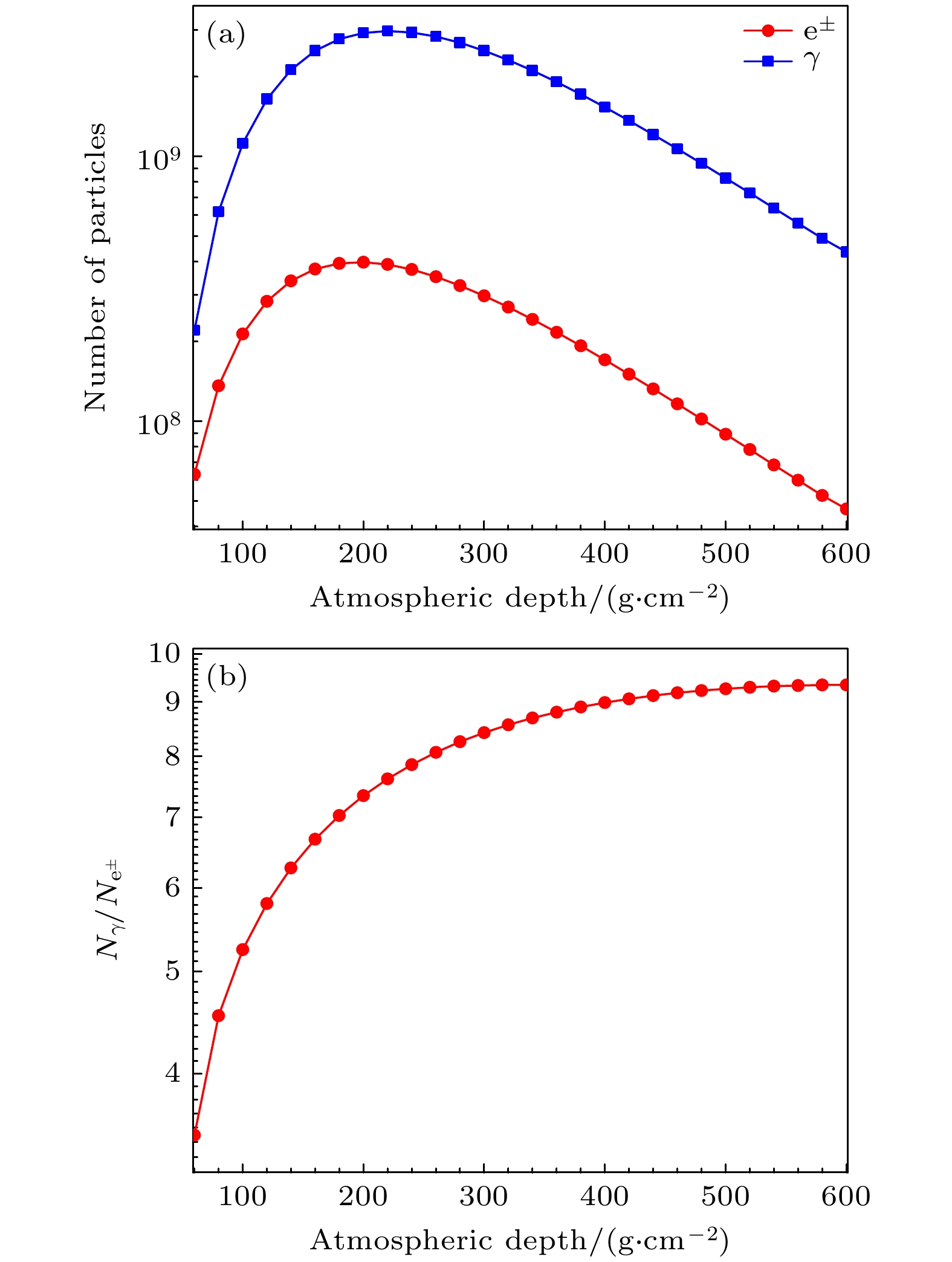
 DownLoad:
DownLoad:
